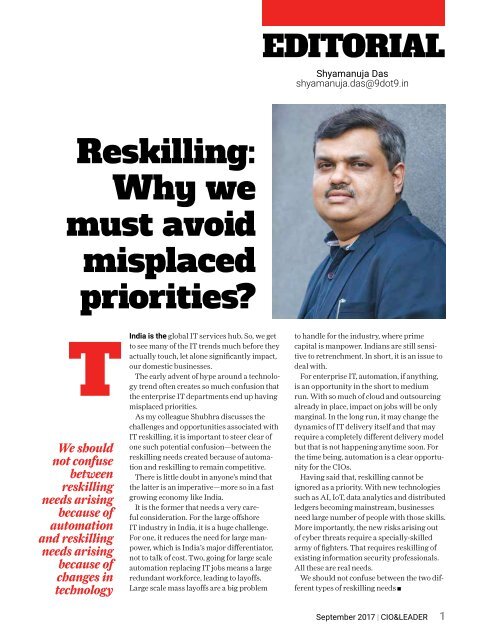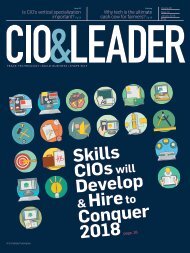CIO & LEADER-Issue-06-September_iPad
The cover story of CIO&Leader issue of September tackles the issue of workforce reskilling in the advent of disruptive technologies such as Artificial Intelligence, IoT, among others.
The cover story of CIO&Leader issue of September tackles the issue of workforce reskilling in the advent of disruptive technologies such as Artificial Intelligence, IoT, among others.
You also want an ePaper? Increase the reach of your titles
YUMPU automatically turns print PDFs into web optimized ePapers that Google loves.
EDITORIAL<br />
Shyamanuja Das<br />
shyamanuja.das@9dot9.in<br />
Reskilling:<br />
Why we<br />
must avoid<br />
misplaced<br />
priorities?<br />
T<br />
We should<br />
not confuse<br />
between<br />
reskilling<br />
needs arising<br />
because of<br />
automation<br />
and reskilling<br />
needs arising<br />
because of<br />
changes in<br />
technology<br />
India is the global IT services hub. So, we get<br />
to see many of the IT trends much before they<br />
actually touch, let alone significantly impact,<br />
our domestic businesses.<br />
The early advent of hype around a technology<br />
trend often creates so much confusion that<br />
the enterprise IT departments end up having<br />
misplaced priorities.<br />
As my colleague Shubhra discusses the<br />
challenges and opportunities associated with<br />
IT reskilling, it is important to steer clear of<br />
one such potential confusion—between the<br />
reskilling needs created because of automation<br />
and reskilling to remain competitive.<br />
There is little doubt in anyone’s mind that<br />
the latter is an imperative—more so in a fast<br />
growing economy like India.<br />
It is the former that needs a very careful<br />
consideration. For the large offshore<br />
IT industry in India, it is a huge challenge.<br />
For one, it reduces the need for large manpower,<br />
which is India’s major differentiator,<br />
not to talk of cost. Two, going for large scale<br />
automation replacing IT jobs means a large<br />
redundant workforce, leading to layoffs.<br />
Large scale mass layoffs are a big problem<br />
to handle for the industry, where prime<br />
capital is manpower. Indians are still sensitive<br />
to retrenchment. In short, it is an issue to<br />
deal with.<br />
For enterprise IT, automation, if anything,<br />
is an opportunity in the short to medium<br />
run. With so much of cloud and outsourcing<br />
already in place, impact on jobs will be only<br />
marginal. In the long run, it may change the<br />
dynamics of IT delivery itself and that may<br />
require a completely different delivery model<br />
but that is not happening anytime soon. For<br />
the time being, automation is a clear opportunity<br />
for the <strong>CIO</strong>s.<br />
Having said that, reskilling cannot be<br />
ignored as a priority. With new technologies<br />
such as AI, IoT, data analytics and distributed<br />
ledgers becoming mainstream, businesses<br />
need large number of people with those skills.<br />
More importantly, the new risks arising out<br />
of cyber threats require a specially-skilled<br />
army of fighters. That requires reskilling of<br />
existing information security professionals.<br />
All these are real needs.<br />
We should not confuse between the two different<br />
types of reskilling needs<br />
<strong>September</strong> 2017 | <strong>CIO</strong>&<strong>LEADER</strong><br />
1














